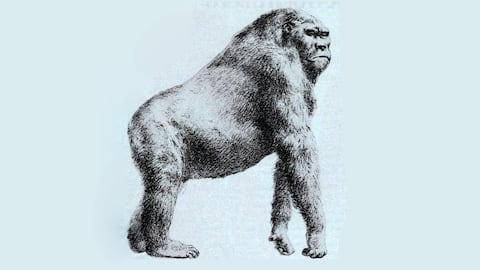Was King Kong real? Scientists discover 10-foot-tall, 660-pound ape's fossils
What's the story
For millions of years, the enormous Gigantopithecus blacki, a 10-foot-tall, 660-pound ape, thrived in China's forest habitat until it mysteriously disappeared during the late middle Pleistocene. Professor Yingqi Zhang from the Chinese Academy of Sciences' Institute of Vertebrate Palaeontology and Palaeoanthropology (IVPP) referred to the extinction of G. blacki as "an enigma in paleontology" and its unknown cause as "the Holy Grail in this discipline." However, recently, scientists discovered its fossils and it's easily among the biggest of its kind.
Details
Decade-long research and diverse analysis methods
A team of international researchers spent over 10 years collecting and examining evidence from 22 cave sites in southern China's Guangxi province. They used six dating methods to analyze cave sediment and fossils, identifying 157 distinct radiometric ages. Co-lead author Kira Westaway, an associate professor at Macquarie University, explained in her study that determining the exact time of a species' disappearance helps establish a target timeframe for environmental reconstruction and behavior assessment.
What Next?
Climate change, inability to adapt led to G. blacki's demise
The researchers found that G. blacki succumbed to climate change, which altered landscapes, seasons, and food availability between 295,000 and 215,000 years ago. The apes were unable to adapt their diet and behaviors, ultimately leading to their extinction. Renaud Joannes-Boyau, an associate professor from Southern Cross University, stated that by directly dating the fossil remains, they confirmed their age aligns with the luminescence sequence in the sediments where they were discovered.
Insights
Teeth provide insight into the species' behavior and diet
Teeth analysis showed that when food was scarce, G. blacki relied on less nutritious options like tree bark, resulting in the species having less energy to forage across a wide range and further reducing its dietary diversity. Joannes-Boyau mentioned that teeth provide a staggering insight into the behavior of the species, indicating stress, diversity of food sources, and repeated behaviors.
Facts
Learning from past extinctions to understand primate resilience
While clarifying the historical record, the researchers emphasized the importance of understanding why species become extinct. Westaway further added that investigating reasons for past unresolved extinctions offers a good starting point to comprehend primate resilience and the fate of other large animals in the past and future. This research was published in the journal Nature.
